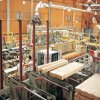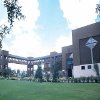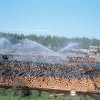Making use of a valuable resource
28 August 2005Another of Chile’s big wood pulp corporations has joined the South American wood based panels club with the recent decision of Empresas CMPC SA to launch its first pine plywood mill.
The Santiago-based pulp and paper group’s subsidiary, CMPC Maderas SA, plans to install a 225,000m3/year line beside the group’s Pacifico pulp mill next year to turn out high-quality sanded panels for the US and European markets.
CMPC, one of Chile’s top forestry and pulp groups, alongside Celulosa Arauco y Constitución SA, is following the lead of Arauco which launched its first plywood line in 1997. Today, Arauco also makes particleboard, MDF and hardboard.
For CMPC, which also manufactures tissues, carton board and writing paper, the move into plywood is a natural one as it wants to make fullest use of its forest resource, which in Chile last year amounted to more than 400,000ha of mainly radiate pine and eucalypt plantations.
“Everything is related to the forest base we have. The timing of this project is tied to the availability of pruned logs in forest areas with radiata pine trees aged from 25 to 28 years old,explained CMPC Maderas’ vice president, Hernan Fournies. Plywood is an obvious added-value product for a company with an abundance of large, high quality ‘radiata’ pine logs, he added.
The group is no novice in the world of wood products for the construction sector. CMPC Maderas already operates three Chilean sawmills at Mulchén, Bucalemu and Nacimiento producing close to one million m3/year of sawn pine timber. In addition, it runs a remanufacturing plant in Los Angeles (Chile) with a 110,000m3/year output of mouldings, solid panels and finger joints.
In the case of its wood products, about 90% of sales – which for 2004 totalled around US$225m – are in the form of exports. Last year, timber went largely to Asia, the Middle East and US, while CMPC sold its remanufactured component production mainly to the US and Japan.
“Our customers are associated with construction, mainly in the US, with some in Europe, so it makes sense for us to offer plywood as a complement to our lumber products,said Mr Fournies, who met WBPI in Santiago recently.
CMPC is already discussing its likely equipment needs with machinery suppliers, including Raute who provided plywood lines for Arauco. The group expected to be ready to choose the supplier at the end of June and to begin work on the mill plan by the end of the year. Start-up is likely by September 2006, according to Mr Fournies.
The group has earmarked a Greenfield site of around 45ha south of the Pacifico pulp mill to create a major forest products complex. The US$56m plywood plan is just the first phase of what may become a bigger scheme, likely also to accommodate a sawmill and perhaps a new mill work operation, the Maderas executive explained.
The choice of the Pacifico site was prompted, not only because of readily available wood resources to feed the plant but also to take advantage of power, steam and water supply from the pulp unit.
Plywood raw material will be drawn from an average distance of between 50 and 60km from plantation forest mainly in the Los Angeles and Temuco areas of Chile’s Eighth and Ninth Regions.
A major part of plywood production will be concentrated on ‘A’ grade panels “for markets where the appearance is really appreciated”, including the US DIY market, the furniture industry and for some applications in construction like decorative panelling, said Mr. Fournies. “Basically, our target is to reach a premium product with a very good appearance. That’s what we are finding is in demand,he added.
CMPC readily accepts that the plywood business in general has been under attack and has sustained damage from the advance of OSB and other panels. But the group remains confident that, with its high quality raw material, good technology and capacity focused on the sanded plywood niche business, it can succeed despite this threat.
The Chilean company means to concentrate primarily on serving the large US market, but sees good opportunities for export sales too, in Mexico and Europe. Last year, CMPC estimates, US consumption of sanded plywood reached 5.2 million m3 out of a total national plywood market totalling 20 million m3/year.
CMPC can take advantage of distribution channels it has developed, chiefly in the US but also in Europe, for its solid wood products. The group, which ships to US ports including Houston, Charleston and Baltimore, has warehouses in Texas and on the East Coast.
The group claims a good environmental pedigree with certified forests and products, and believes its work in polishing its corporate image, particularly in eco-sensitive markets, will also aid its success in the plywood business.
So, with plywood under its belt, is CMPC set to follow Arauco’s dramatic, full scale incursion into the business of wood based panels? In barely seven years, through major capital investment and key acquisitions in Chile, Brazil and Argentina, Arauco has become a regional industry leader.
The answer is, apparently, not. CMPC may later expand plywood production, possibly in another country in South America’s ‘Cono Sur’ or Southern Cone. But it still sees its core role as that of a pulp and paper maker, according to Mr Fournies.
“Technically, any other [panel] opportunity, like MDF or OSB, we would compete for the raw material that we are now using for pulp. The company is committed to its pulp business,stressed the vice president, who has served 18 years with CMPC’s wood products division.
In fact, the plywood project is far from being the only current investment scheme on the minds of CMPC senior management. As if to emphasise its firm commitment to pulping, the group is to launch its huge 780,000 ton/year ‘Santa Fé II’ pulp line, costing some US$700m, by September 2006.
CMPC Maderas has other expansion projects including the US$28m expansion next year of sawn wood capacity by 500,000m3/year at its Mulchen sawmill, rebuilt after fire destroyed the main mill and machinery in 2003. A US$10m project will see capacity growth for mouldings and edge-glued panels at the Los Angeles remanufacturing plant by early 2006.
In addition, CMPC, which is extending its plantations in both Chile and Argentina, expects to develop new solid wood products from its Chilean mature eucalypt forest. Overall, at the start of 2004, its planted ‘globulus’ and ‘nitens’ eucalypt resource in both countries amounted to 120,000ha.
At the end of 2004, Empresas CMPC SA, one of the largest firms quoted on the Chilean Stock Exchange, reported annual group sales of around US$1.6bn. The group is controlled by the Matte family, one of the country’s top business leaders.


